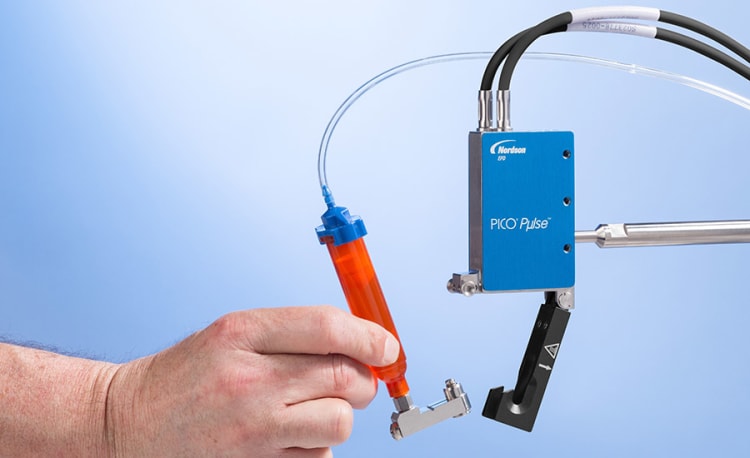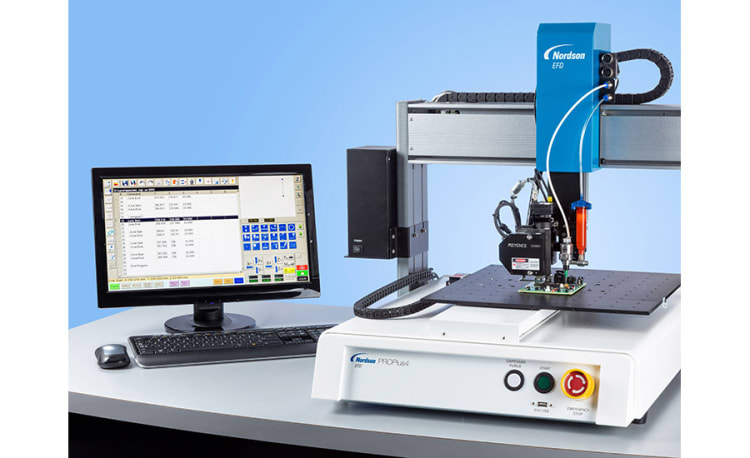Equipment maintenance
Equipment maintenance appeared to be a challenge across the board regardless of the dispensing method aside from those using cotton swabs, toothpicks, squeeze bottles and medical syringes to apply assembly fluids.
Here’s how it breaks down by fluid dispensing method:
- 46% of 2017 and 45% of 2018 respondents rated this as the top challenge when using positive displacement dispensers
- 39% of 2017 and 33% of 2018 respondents using pneumatic valve systems rated this as a challenge
- 35% of 2018 respondents rated equipment maintenance as a challenge when using pneumatic jetting valve systems
While interesting that more respondents rated positive displacement dispensers as a challenge when it comes to equipment maintenance versus pneumatic valve and jet valve systems, it is not surprising. Positive displacement dispensers, such as volumetric pumps, generally have more intricate parts that require more time to disassemble and clean. The plus side of positive displacement systems is that they provide continuous, repeatable dispensing regardless of fluid viscosity or changes in viscosity over time. For many types of applications, the benefits outweigh the downside of taking longer to clean.
Recent advances in dispensing technology, including pneumatic valves and piezo-electric jetting valves, reduce maintenance time through innovative product design. Quick release clasps integrated into valve design allow operators to quickly remove the fluid body while keeping the valve mounted to automated systems. Not having to remove the valve to clean it and return it to service saves a great deal of maintenance time. In fact, if a manufacturer had more than one fluid body prepped ahead of time, the switch could be seamless, minimizing downtime for service to only a few minutes.

Need for faster production
The need for faster production was reported as a top challenge for manufacturers using cotton swabs and toothpicks to apply assembly fluids. 44% of 2018 respondents expressed this as the main challenge of this dispensing method. Surprisingly, 43% of respondents using tabletop automated systems said the need for faster production was a top concern.
Often when higher throughput is required, an automated tabletop dispensing robot increases the speed of production by allowing faster dispensing on a batch of parts versus one-by-one applications when dispensing fluid manually with a toothpick or squeeze bottle.
One reason respondents may have cited faster production as a pain point of automated dispensing systems could be that some manufacturers purposely design robots to move slower so they don’t require being enclosed in safety guarded systems.
Recent advances in tabletop dispensing robots include purposeful product design decisions for decreasing dispense cycle times. These newer robots feature ball screw actuation instead of belts for that very purpose. They also achieve best-in-class positional repeatability at ± 0.003 mm.
Fluid waste, operator training, and rework
The final three in the ranking of top fluid dispensing challenges for manufacturers were: fluid waste, operator training and rework / rejects. Fluid waste can certainly be a costly challenge depending on the type of fluid used in the assembly process. One way to reduce fluid waste is to use disposable dispensing components, such as syringe barrels and pistons, that are right for the fluid type to prevent leaving any fluid left in the barrel after dispensing. Some components are designed to work as a system to reduce waste. Shorter fluid feed tubing between the fluid reservoir and dispense valve can also help reduce waste. Using dispense valves designed with zero dead fluid volume inside the valve can also help ensure all the fluid is being dispensed so there is minimal waste.
Operator training is the next challenge. This is true more so with sophisticated jetting systems and tabletop robots. One way to overcome this challenge is to work with a dispensing equipment provider that will test the assembly fluid and application in-house on the equipment prior to purchase. This not only provides confirmation that the equipment will deliver the desired result, but also generates documented parameters to use as a guide when setting up the equipment and training operators.
Recent upgrades in proprietary software used to program tabletop automated dispensing systems can also significantly reduce the time it takes to train operators. Some equipment vendors have invested a great deal in developing an intuitive software interface to simplify setup and programming of dispensing robots to reduce operator training requirements.

Lastly, rework and rejects are obviously a significant challenge. However, using the right dispensing equipment can greatly minimize the amount of rework and rejects. The more sophisticated the dispensing system, the less likely the chance of creating rework and rejects. Working with a partner who understands the nuances between all the different types of dispensing equipment and the type of setup required for a specific application is key.
Topline insight
Optimizing fluid dispensing processes to make production operations run faster, smoother and with a heightened return on investment can be achieved by using the right equipment and working with an experienced partner with a wide range of solutions to offer. Minor process improvements, such as making sure assembly fluids are air-free prior to dispensing, can also help optimize fluid dispensing processes.



